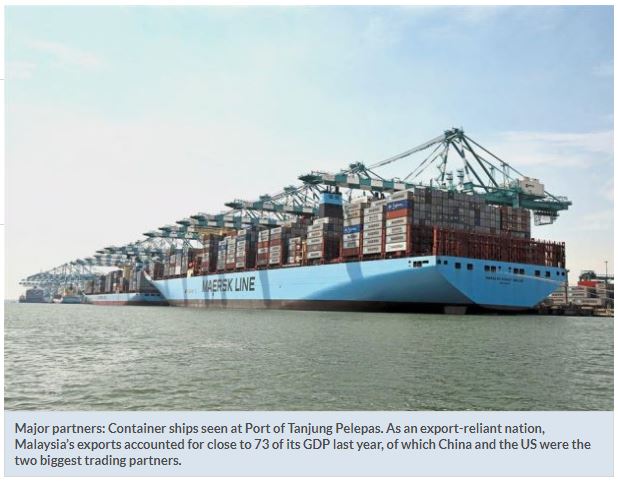Malaysia seen to face lower trade surplus due to US-China trade war
PETALING JAYA: Despite the escalation in the US-China trade war which may dent exports of emerging markets, Malaysia is poised to maintain a trade surplus for this year and 2019, albeit slightly lower than in 2017.
Towards this end, some economists told StarBiz that they are projecting a current account surplus of between 2% and 2.5% of gross domestic product (GDP) for 2018 and 2019. Last year, current account surplus-to-GDP stood at 3%.
As an export-reliant nation, the country’s exports accounted for close to 73% of its GDP last year, of which China and the US were the two biggest trading partners.
AmBank Group chief economist Anthony Dass told StarBiz that Malaysia’s exports are expected to grow around 7% in 2018 and 5% in 2019, based on the bank’s global export volume growth projected at 4% and 3.5%, respectively, for this year and next.
He said the escalation in trade conflict between China and the US would result in some “knock-on” effect on Malaysia’s trade, both directly and indirectly, as the US and China are the nation’s two biggest trading partners with an exposure of 9.5% and 13.5%, respectively, bringing the cumulative exposure to 23% of trade.
The trade war with the imposition of higher import duties to the US would inflict secondary effects on Malaysia because of its integrated supply chains most notably through China, as well as through a shift in demand/supply and price dynamics of key inputs, including commodities, he said.
Business activities in the areas like electronic components such as telecommunications equipment and electrical apparatus and parts – which are inputs for final products – account for 21% of Malaysia’s total exports.
“However, the Comprehensive and Progressive Agreement for Trans-Pacific Partnership among the 11 remaining members of the original Trans-Pacific Partnership (TPP), minus the US, could offer some new opportunities like access into new markets that would benefit palm oil, rubber and other electronics exporters.
“The weak ringgit will provide some competitive edge. So, we foresee the economy to maintain trade surplus as imports is also expected to soften.
“That means, the current account surplus is expected to hover around 2%-2.5% of GDP in 2018 and 2019, slightly lower than the 3% of GDP in 2017,’’ Dass added.
OCBC Bank (M) Bhd head of global treasury Stantley Tan said although trade tension escalation may adversely affect demand for Malaysian intermediate goods, this would potentially be mitigated by substitution effects as businesses searched for alternative supply chains.
“Electrical and electronic (E&E) exports, which constitute an increasing portion of total exports, could also find support in the US’ willingness to grant certain exemptions (for example, Apple product inputs being a case in point), which may set a precedent for other E&E-related goods. All in all, the trade balance should remain in surplus for 2018 and 2019,’’ he said.
Dass is revising downwards the bank’s 2018 and 2019 projected GDP growth targets from 5.5% and 5.3% previously to 5.0% and 4.5%, respectively.
Tan is lowering the 2018 GDP forecast to 4.8%, and between 4.9% and 5.2% for 2019, due to austerity in domestic public spending and risk of increase in global headwinds.
Meanwhile, Malaysian Rating Corp Bhd chief economist Nor Zahidi Alias said he foresaw GDP growth for 2018 to be in the region of 5% on account of lower public expenditure and slower growth momentum in private consumption and investment.
“Specifically, growth will be adversely affected by government expenditure cuts while the reinstatement of sales and service tax will likely drag private consumption growth down in the coming quarters.
“External trade will also act as a drag to headline growth as export performance is affected by global uncertainties due to the escalating trade war.
“The high base factor in the second half of 2017 also contributes to our lower growth projection for the second half of 2018. As for 2019, we foresee the growth momentum to moderate further, with headline GDP growth of 4.3% to 4.8%,’’ he noted.
On the likelihood of more capital outflows from Malaysia due to the geopolitical risks, Zahidi said if the negative sentiment towards emerging market economies persists in the near term, Malaysia could record additional outflows from its financial market as foreign capital rushed back to safe-haven financial assets.
Net foreign capital outflows in Malaysia’s bond and equity markets totalled about RM28bil between January-August 2018.
On the currency outlook, Tan said OCBC Bank has revised the US dollar-ringgit projection upwards to 4.1689 by year-end and 4.1922 for June 2019.
“Looking ahead, we see little reason for the ringgit to strengthen at this time while the Pakatan Harapan government sorts out the delicate fiscal balancing act, stemming from the discovery of higher government indebtedness and financial obligations,’’ he said.
Zahidi said on a real-effective exchange-rate basis (exchange rate against major trading partners and adjusted to inflation), the ringgit looked relatively low and attractive by historical standard.
However, he said the risk of a slight weakness against the greenback in the near term could not be ruled out, especially if the strength of the US dollar continued in the near term.
Dass said currency market volatility is still on the rise, led primarily by the emergence of severe exchange-rate adjustments in the developing market.
“At the same time, Malaysia’s domestic scenario should be presenting a more clearer picture. Hence, in the near term, we foresee ringgit to exhibit a volatility of 2%-3% from the current levels, with the trend moving into a strengthening note as we get into 2019,’’ he said.
Source: https://www.thestar.com.my/business/business-news/2018/09/24/malaysia-to-maintain-trade-surplus-despite-trade-war/#ZDgcSbDvAizPcIoo.99


 Thailand
Thailand




